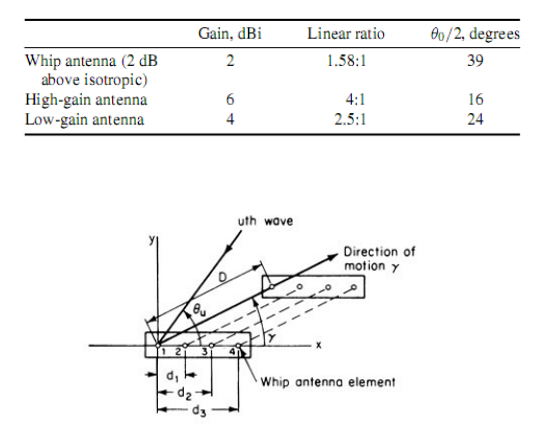Explain the following, (a) Roof mounted antennas (b) Glass mounted antennas (c) Mobile high gain antennas.
9. Explain the following,
(a) Roof mounted antennas
(b) Glass mounted antennas
(c) Mobile high gain antennas.
Mobile Antennas:
The requirement of a mobile (motor-vehicle–mounted) antenna is an omnidirectional antenna that can be located as high as possible from the point of reception. However, the physical limitation of antenna height on the vehicle restricts this requirement. Generally, the antenna should at least clear the top of the vehicle. Patterns for two types of mobile antenna are shown in Fig. 9.1.
Roof-Mounted Antenna:
The antenna pattern of a roof-mounted antenna is more or less uniformly distributed around the mobile unit when measured at an antenna range in free space as shown in Fig.9.2. The 3-dB high gain antenna shows a 3-dB gain over the quarter-wave antenna. However, the gain of the antenna used at the mobile unit must be limited to 3 dB because the cell-site antenna is rarely as high as the broadcasting antenna and out-of-sight conditions often prevail. The mobile antenna with a gain of more than 3 dB can receive only a limited portion of the total multi path signal in the elevation as measured under the out-of-sight condition.
 |
| Vertical angle of signal arrival |
Glass-Mounted Antennas:
There are many kinds of glass-mounted antennas. Energy is coupled through the glass; therefore, there is no need to drill a hole. However, some energy is dissipated on passage through the glass. The antenna gain range is 1 to 3 dB depending on the operating frequency. The position of the glass-mounted antenna is always lower than that of the roof-mounted antenna; generally there is a 3-dBdifference between these two types of antenna. Also, glass mounted antennas cannot be installed on the shaded glass found in some motor vehicles because this type of glass has a high metal content.
Mobile High-Gain Antennas:
A high-gain antenna used on a mobile unit has been studied. This type of high-gain antenna should be distinguished from the directional antenna. In the directional antenna, the antenna beam pattern is suppressed horizontally; in the high-gain antenna, the pattern is suppressed vertically. To apply either a directional antenna or a high-gain antenna for reception in a radio environment, we must know the origin of the signal. If we point the directional antenna opposite to the transmitter site, we would in theory receive nothing. In a mobile radio environment, the scattered signals arrive at the mobile unit from every direction with equal probability. That is why an omnidirectional antenna must be used. The scattered signals also arrive from different elevation angles. Lee and Brandt used two types of antenna, one λ/4 whip antenna with an elevation coverage of 39◦ and one 4-dB-gain antenna (4-dB gain with respect to the gain of a dipole) with an elevation coverage of 16◦ and measured the angle of signal arrival in the suburban Keyport-Matawan area of New Jersey. There are two types of test: a line-of-sight condition and an out-of-sight condition. In Lee and Brandt’s study, the transmitter was located at an elevation of approximately 100 m (300 ft) above sea level. The measured areas were about 12 m (40 ft) above sea level and the path length about 3 mi. The received signal from the 4-dB-gain antenna was 4 dB stronger than that from the whip antenna under line-of-sight conditions. This is what we would expect. However, the received signal from the 4-dB-gain antenna was only about 2 dB stronger than that from the whip antenna under out-of-sight conditions. This is surprising. The reason for the latter observation is that the scattered signals arriving under out-of- sight conditions are spread over a wide elevation angle. A large portion of the signals outside the elevation angle of 16◦ cannot be received by the high-gain antenna. We may calculate the portion being received by the high-gain antenna from the measured beam width. For instance, suppose that a 4:1 gain (6 dBi) is expected from the high-gain antenna, but only 2.5:1 is received. Therefore, 63 percent of the signal is received by the 4-dB-gain antenna (i.e., 6 dBi) and 37 percent is felt in the region between 16 and 39◦
Therefore, a 2- to 3-dB-gain antenna (4 to 5 dBi) should be adequate for general use. An antenna gain higher than 2 to 3 dB does not serve the purpose of enhancing reception level. Moreover, measurements reveal that the elevation angle for scattered signals received in urban areas is greater than that in suburban areas.


%20Roof%20mounted%203-dB-gain%20collinear%20antenna.PNG)

